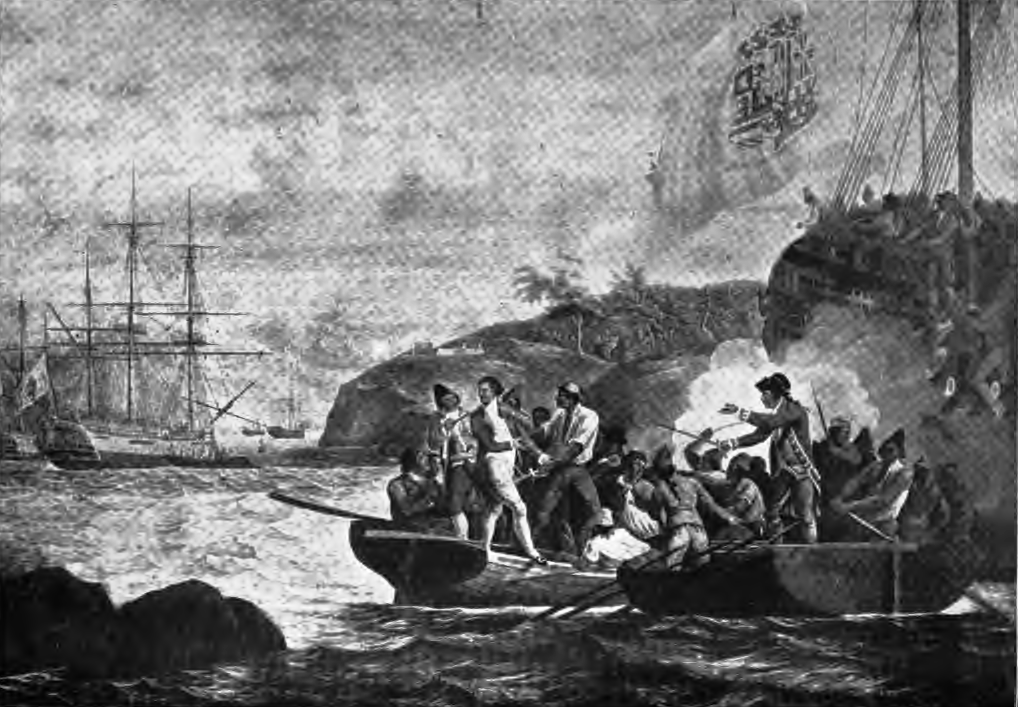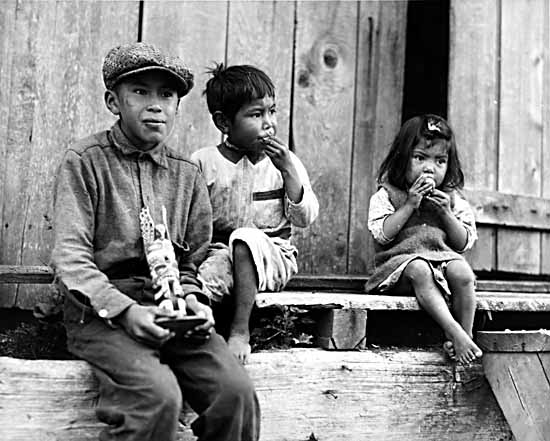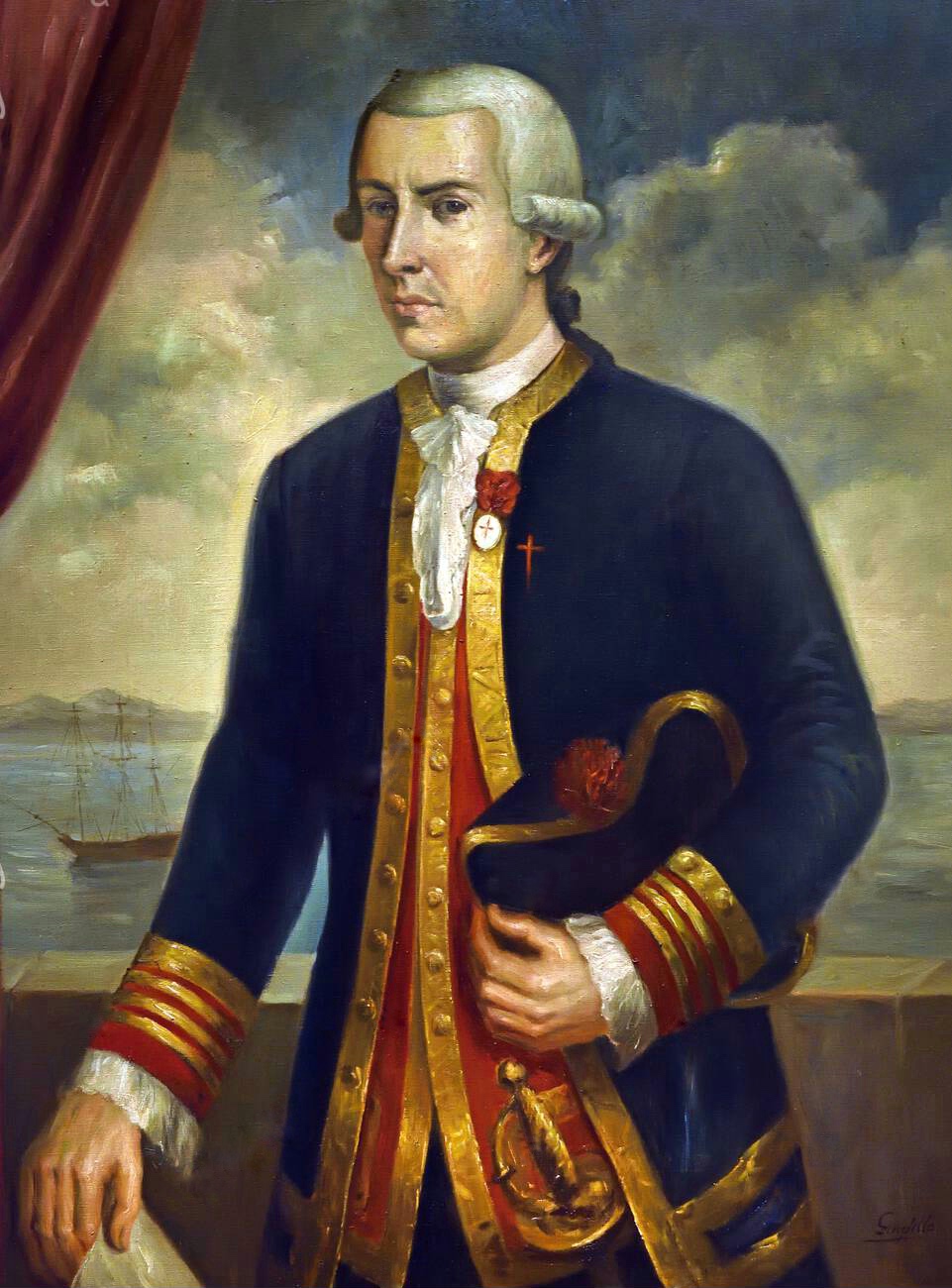|
Santa Cruz De Nuca
Santa Cruz de Nuca (or Nutca) was a Spanish colonial fort and settlement and the first European colony in what is now known as British Columbia. The settlement was founded on Vancouver Island in 1789 and abandoned in 1795, with its far northerly position making it the "high-water mark" of verified northerly Spanish settlement along the North American west coast. The colony was established with the Spanish aim of securing the entire west coast of the continent from Alaska southwards, for the Spanish crown. Due to the presence and activities of several British maritime fur trading ships in the same region, and the Russian colonization of Alaska further north, this Spanish attempt at making such a substantial claim for possession and conquest along the North American west coast failed. The colony was briefly abandoned between October 1789 and April 1790. In 1795 the colony was permanently abandoned following the settlement and signing of the Nootka Convention. This final Spanish ab ... [...More Info...] [...Related Items...] OR: [Wikipedia] [Google] [Baidu] |
Yuquot
Yuquot , also known as Friendly Cove, is a small settlement of around six people—the Williams family of the Mowachaht band—plus two full-time lighthouse keepers, located on Nootka Island in Nootka Sound, just west of Vancouver Island, British Columbia, Canada. It was the summer home of Chief Maquinna and the Mowachaht/Muchalaht (Nuu-chah-nulth) people for generations, housing approximately 1,500 people in 20 traditional wooden longhouses. The name means "Wind comes from all directions" in Nuu-chah-nulth. The community is located within the Strathcona Regional District but like all Indian Reserve communities is not governed by nor represented in the regional district. The Mowchaht/Muchalaht First Nations are rather part of the Nuu-chah-nulth Tribal Council, which unites the governments of the indigenous communities of the Island's West Coast. The Canadian government declared Friendly Cove a National Historic Site in 1923, with recognition of the significance of the Spanish c ... [...More Info...] [...Related Items...] OR: [Wikipedia] [Google] [Baidu] |
Mowachaht/Muchalaht First Nations
The Mowachaht/Muchalaht First Nations are a First Nations government on the west coast of Vancouver Island in the Canadian province of British Columbia. The Mowachaht/Muchalaht First Nations are a member nation of the Nuu-chah-nulth Tribal Council, which spans all Nuu-chah-nulth-aht peoples (incorrectly known as "Nootka") except for the Pacheedaht First Nation. Their main reserve is at Gold River, British Columbia but the Mowachaht are originally from Yuquot on Nootka Sound, known to history as Friendly Cove, scene of the Nootka Incident and, later, the negotiations and eventual implementation of the Nootka Conventions between Britain and Spain, hosted by the Mowachaht chief Maquinna. Name The Mowachaht (pronounced ), which translates to people of the deer, originate from a place called Friendly Cove, or Yuquot (translates to "Wind comes from all directions"). The name Muchalaht translates to the people who hover over the river or the people over the river. History In the mid-t ... [...More Info...] [...Related Items...] OR: [Wikipedia] [Google] [Baidu] |
Robert Gray (sea Captain)
Robert Gray (May 10, 1755 – ) was an American Merchant Sea Captain who is known for his achievements in connection with two trading voyages to the northern Pacific coast of North America, between 1790 and 1793, which pioneered the American maritime fur trade in that region. In the course of those voyages, Gray explored portions of that coast and in the year 1790 he completed the first American circumnavigation of the world. He was also noted for coming upon and naming the Columbia River, in 1792, while on his second voyage. Gray's earlier and later life are both comparatively obscure. He was born in Tiverton, Rhode Island, and may have served in the Continental Navy during the American Revolutionary War. After his two famous voyages, he carried on his career as a sea captain, mainly of merchantmen in the Atlantic. He intended a third voyage to the Northwest Coast, but his ship was captured by French privateers, during the Franco-American Quasi-War. Later in that conflict, Gray ... [...More Info...] [...Related Items...] OR: [Wikipedia] [Google] [Baidu] |
Trading Post
A trading post, trading station, or trading house, also known as a factory, is an establishment or settlement where goods and services could be traded. Typically the location of the trading post would allow people from one geographic area to trade in goods produced in another area. In some examples, local inhabitants could use a trading post to exchange local products for goods they wished to acquire. Examples Major towns in the Hanseatic League were known as ''kontors'', a form of trading posts. Charax Spasinu was a trading post between the Roman and Parthian Empires. Manhattan and Singapore were both established as trading posts, by Dutchman Peter Minuit and Englishman Stamford Raffles respectively, and later developed into major settlements. Other uses * In the context of scouting, trading post usually refers to a camp store in which snacks, craft materials, and general merchandise are sold. "Trading posts" also refers to a cub scout actitivty in which cub teams (or indivi ... [...More Info...] [...Related Items...] OR: [Wikipedia] [Google] [Baidu] |
George Vancouver
Captain George Vancouver (22 June 1757 – 10 May 1798) was a British Royal Navy officer best known for his 1791–1795 expedition, which explored and charted North America's northwestern Pacific Coast regions, including the coasts of what are now the Canadian province of British Columbia as well as the US states of Alaska, Washington and Oregon. He also explored the Hawaiian Islands and the southwest coast of Australia. Vancouver Island, the city of Vancouver in British Columbia, Vancouver, Washington in the United States, Mount Vancouver on the Canadian–US border between Yukon and Alaska, and New Zealand's fourth-highest mountain, also Mount Vancouver, are all named after him. Early life George Vancouver was born in the seaport town of King's Lynn (Norfolk, England) on 22 June 1757 - the sixth and youngest child of John Jasper Vancouver, a Dutch-born deputy collector of customs, and Bridget Berners. He came from an old respected family. The surname Vancouver comes ... [...More Info...] [...Related Items...] OR: [Wikipedia] [Google] [Baidu] |
John Meares
John Meares (c. 1756 – 1809) was an English navigator, explorer, and maritime fur trader, best known for his role in the Nootka Crisis, which brought Britain and Spain to the brink of war. Career Meares' father was Charles Meares, "formerly an attorney of great eminence, and for several years pursuivant of his Majesty's Court of Exchequer in Dublin". In 1771, Meares joined the Royal Navy as a captain's servant and was commissioned a lieutenant in 1778. In 1783 he joined the merchant service and in 1785, based in India, formed the ''Northwest America Company'' for collecting sea otter furs by trade with the indigenous peoples of the Pacific Northwest Coast and selling them in China. The East India Company held a monopoly on British trade in the Pacific and required all British traders to be licensed with the company and pay duties. Meares did not license his ships with the East India Company and instead tried to conceal the illegal activity by using the flag of Portugal. Meares r ... [...More Info...] [...Related Items...] OR: [Wikipedia] [Google] [Baidu] |
Nootka Sound
, image = Morning on Nootka Sound.jpg , image_size = 250px , alt = , caption = Clouds over Nootka Sound , image_bathymetry = , alt_bathymetry = , caption_bathymetry = Map of Nootka Sound , location = Vancouver Island, British Columbia , group = , coordinates = , type = Sound , etymology = , part_of = , inflow = , rivers = , outflow = , oceans = Pacific Ocean , catchment = , basin_countries = , agency = , designation = , date-built = , engineer = , date-flooded = , length = , width = , area = , depth = , max-depth = , volume = , residence_time = , salinity = , shore = , elevation = , temperature_hi ... [...More Info...] [...Related Items...] OR: [Wikipedia] [Google] [Baidu] |
Esteban José Martínez
Esteban () is a Spanish male given name, derived from Greek Στέφανος (Stéphanos) and related to the English names Steven and Stephen. Although in its original pronunciation the accent is on the penultimate syllable, English-speakers tend to pronounce it as a proparoxytone . People with the given name * Esteban Alvarado, Costa Rican goalkeeper * Esteban Andrés Suárez, Spanish football goalkeeper * Esteban Cambiasso, Argentine footballer * Esteban de la Fuente, Argentine basketball player * Esteban Fuertes, Argentine footballer * Esteban Granero, Spanish footballer * Esteban Guerrieri, Argentine racing driver * Esteban Gutiérrez, Mexican racing driver * Esteban Lazo Hernández, Cuban politician * Esteban Loaiza, Mexican retired baseball player * Esteban Navarro, Spanish novelist * Esteban Ocon, French racing driver * Esteban Pérez, Argentine basketball player * Esteban Solari, Argentine football player * Esteban Trapiello, Venezuelan businessman * Esteban Tuero, Ar ... [...More Info...] [...Related Items...] OR: [Wikipedia] [Google] [Baidu] |
Manuel Antonio Flórez
Manuel Antonio Flórez Maldonado Martínez Ángulo y BodquínReal Academia de la historiaDiccionario Bibliográfico español - Manuel Antonio Flórez/ref> (in full, ''Manuel Antonio Flórez Maldonado'') (May 27, 1723 in Seville, Spain – March 20, 1799 in Madrid) was a general in the Spanish navy and viceroy of New Granada (1776 – November 26, 1781) and New Spain (August 17, 1787 to October 16, 1789). Early career Flórez entered the royal navy of Spain, where he commanded various ships of war fighting pirates, in both the Mediterranean and in Spanish possessions in America. He distinguished himself for his valor as well as his knowledge, and was made a knight of the military Order of Calatrava. He became commandant of the Naval Department at el Ferrol, a major naval base, shipbuilding center and arsenal in northwestern Spain. He served in that position for four years (1771–75). Flórez was named viceroy of New Granada, and sailed to take up the position on Decem ... [...More Info...] [...Related Items...] OR: [Wikipedia] [Google] [Baidu] |
Viceroy Of New Spain
The following is a list of Viceroys of New Spain. In addition to viceroys, the following lists the highest Spanish governors of the Viceroyalty of New Spain, before the appointment of the first viceroy or when the office of viceroy was vacant. Most of these individuals exercised most or all of the functions of viceroy, usually on an interim basis. Governor of the West Indies This office covered the territories that were discovered by Christopher Columbus. : 1492–1499 – Christopher Columbus, as governor and viceroy of the West Indies : 1499–1502 – Francisco de Bobadilla, as governor of the West Indies : 1502–1509 – Nicolás de Ovando y Cáceres, as governor of the West Indies : 1509–1518 – Diego Columbus, as governor of the West Indies until 1511, thereafter as viceroy Governor of New Spain This office covered the territories that were claimed by Hernán Cortés. The office covered the territories that were under the control of the Governor of the Indies after 152 ... [...More Info...] [...Related Items...] OR: [Wikipedia] [Google] [Baidu] |
Spanish Expeditions To The Pacific Northwest
During the Age of Exploration, the Spanish Empire undertook several expeditions to the Pacific Northwest of North America. Spanish claims to the region date to the papal bull of 1493, and the Treaty of Tordesillas signed in 1494. In 1513, this claim was reinforced by Spanish explorer Vasco Núñez de Balboa, the first European to sight the Pacific Ocean, when he claimed all lands adjoining this ocean for the Spanish Crown. Spain only started to colonize the claimed territory north of present-day Mexico in the 18th century, when it settled the northern coast of Las Californias. Starting in the mid-18th century, Spain's claims in the Pacific Northwest began to be contested by the British and Russians, who established fur trading posts and other settlements in the region. King Charles III of Spain and his successors sent several expeditions from New Spain to present-day Canada and Alaska between 1774 and 1793 to strengthen the Spanish claims. These efforts would eventually come ... [...More Info...] [...Related Items...] OR: [Wikipedia] [Google] [Baidu] |
New Spain
New Spain, officially the Viceroyalty of New Spain ( es, Virreinato de Nueva España, ), or Kingdom of New Spain, was an integral territorial entity of the Spanish Empire, established by Habsburg Spain during the Spanish colonization of the Americas and having its capital in Mexico City. Its jurisdiction comprised a huge area that included what is now Mexico, the Western and Southwestern United States (from California to Louisiana and parts of Wyoming, but also Florida) in North America; Central America, the Caribbean, very northern parts of South America, and several territorial Pacific Ocean archipelagos. After the 1521 Spanish conquest of the Aztec empire, conqueror Hernán Cortés named the territory New Spain, and established the new capital, Mexico City, on the site of the Tenochtitlan, the capital of the Mexica (Aztec) Empire. Central Mexico became the base of expeditions of exploration and conquest, expanding the territory claimed by the Spanish Empire. With the polit ... [...More Info...] [...Related Items...] OR: [Wikipedia] [Google] [Baidu] |



_1900.jpg)




